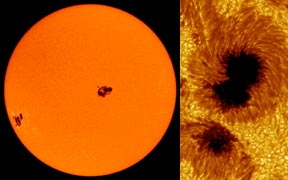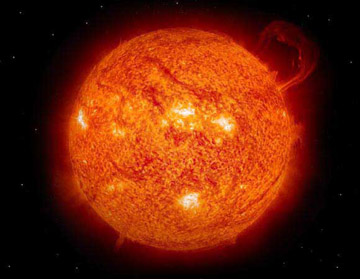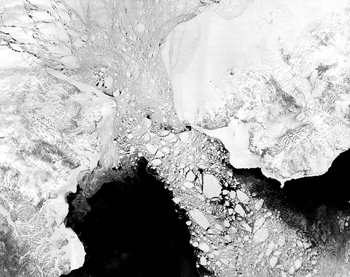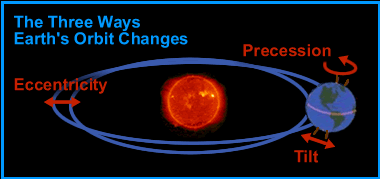The shape of Earth's orbit becomes more or less oval (eccentricity), Earth wobbles as it spins (precession), and Earth's axis changes too (tilt). All these changes, over thousands of years, causes Earth's climate to change.
Click on image for full size
Windows to the Universe
How the Sun Affects Climate: Solar and Milankovitch Cycles
Earth gets all its energy from the
Sun and it is the Sun's energy that keeps
Earth warm. But the amount of energy Earth receives is not always the same. Changes
in the Sun and changes in
Earth's
orbit affect the amount of energy that
reaches the Earth.
The 11-Year Solar Cycle
When the Sun has fewer sunspots, it gives off less energy, less energy makes
its way to Earth, and our planet cools down. More than three hundred years ago,
when the climate was cooler for a time called the "Little Ice Age",
people noticed there were no sunspots for several decades. Over time, scientists
have noticed a pattern in the number of sunspots. About every 11 years the number
of sunspots reaches a high and then decreases again.
Milankovitch Cycles
Over thousands of years, changes in Earth's orbit cause changes in the
amount of the Sun's energy that gets to the planet. Over the past several
million years these changes have caused cycles of global warming and cooling.
There are three ways that Earth's orbit changes over time.
- Eccentricity: The shape of Earth's orbit around the
Sun becomes slightly more and then less oval every 100,000 years.
- Precession: Earth wobbles on it axis as it spins, completing
a full wobble every 23,000 years.
- Tilt: The angle of the Earth's axis relative to the plane of its orbit changes about three degrees every 41,000 years.
Once the Sun's energy reaches the Earth, several things can happen. The
energy can be absorbed by the planet, reflected back into space, or become trapped
in the atmosphere.
You might also be interested in:

Sunspots are dark, planet-sized regions that appear on the "surface" of the Sun. Sunspots are "dark" because they are colder than the areas around them. A large sunspot might have a temperature of about
...more
Some of the factors that have an affect on climate, like volcanic eruptions and changes in the amount of solar energy, are natural. Others, like the addition of greenhouse gases to the atmosphere, are
...more
Sometimes, a small change in the Earth can lead to a big change in climate. A new study shows that changes in the Bering Strait might have affected ocean currents and climate worldwide thousands of years
...more
Looking for online content that can be used for a climate change education course or module? Pages linked below can be used to support an introductory climate change education for either a unit or a full
...more
Leaders from 192 countries are meeting in Copenhagen, Denmark December 7-18, 2009 to decide how the world will deal with climate change. They are trying to decide how to limit the amount of greenhouse
...more
The climate where you live is called regional climate. It is the average weather in a place over more than thirty years. To describe the regional climate of a place, people often tell what the temperatures
...more
Even though only a tiny amount of the gases in Earth’s atmosphere are greenhouse gases, they have a huge effect on climate. There are several different types of greenhouse gases. The major ones are carbon
...more















